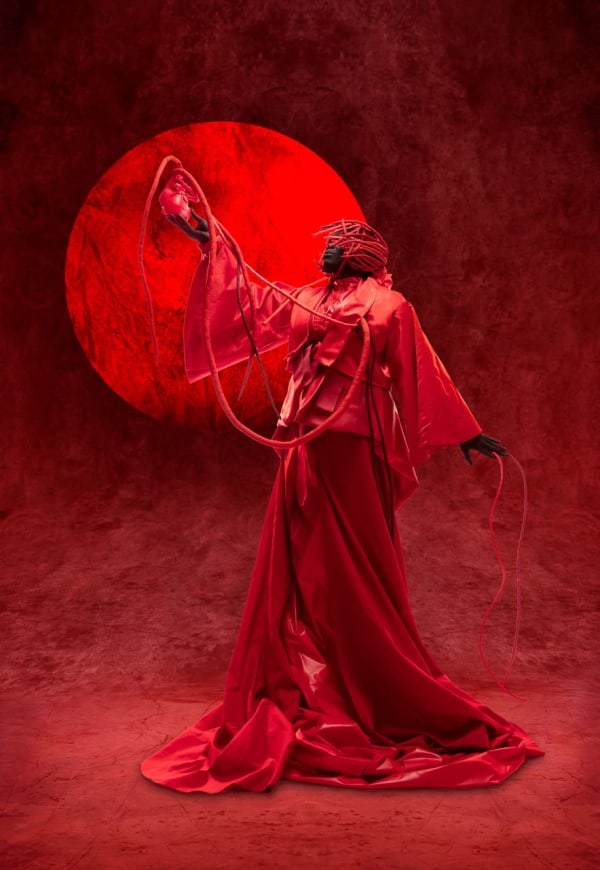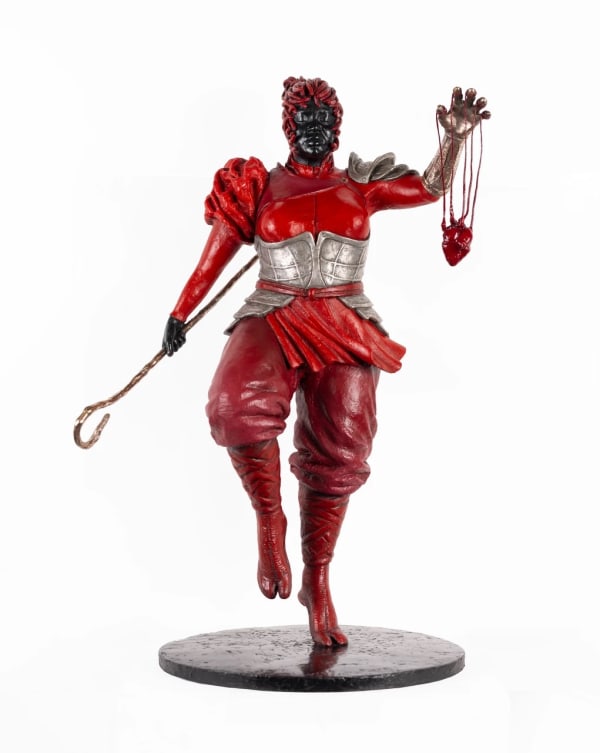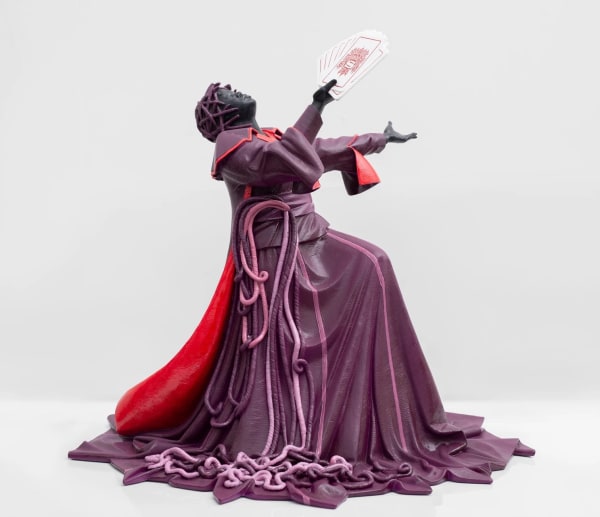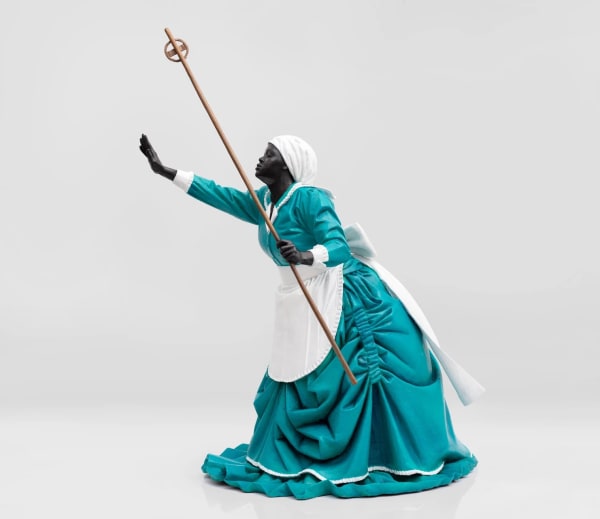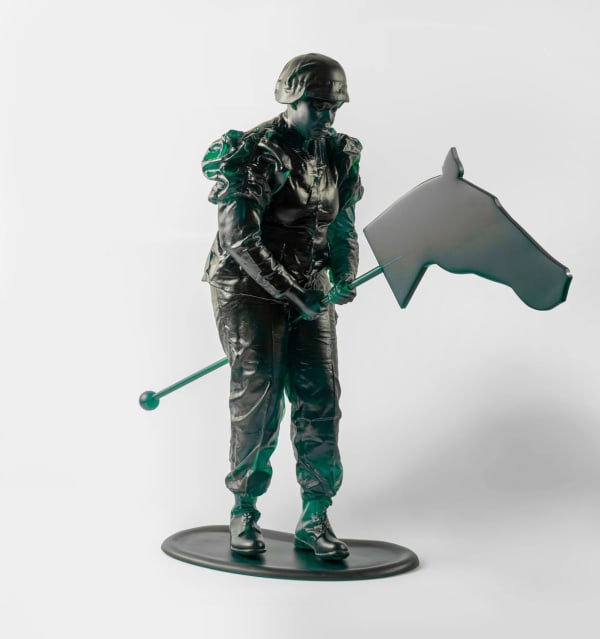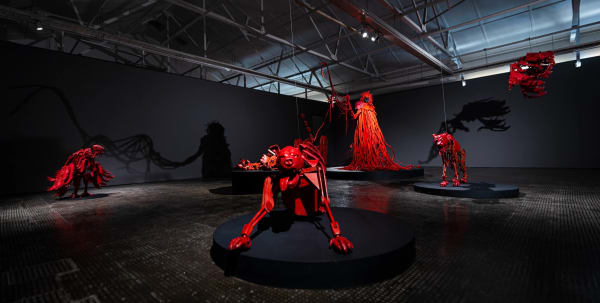“History is a liar”: Mary Sibande’s Theatre of Red
Sharlene Khan
The colonized races, those slaves of modern times, are impatient. They know that this apparent folly alone can put them out of reach of colonial oppression. A new type of relations is established in the world. The under-developed peoples try to break their chains, and the extraordinary thing is that they succeed. It could be argued that in these days of sputniks it is ridiculous to die of hunger; but for the colonized masses the argument is more down-to-earth (Fanon, 1961/2001: 58).[1]
Mary Sibande will forever be linked to the character of Sophie she created when she emerged as a young artist. Sophie, in her blue Zionist-Victorian outfits, slowly unravels the domestic space of whiteness through attention paid to black women’s bodies in those spaces, but then plunging into the depths of that seemingly placid Sophie as she mends the superhero’s costume. Sibande showed us that within Sophie was an entire rich universe of dreams, fantasies and aspirations – that the limitations imposed through racial epidermalisation did not stop someone from going deep within themselves and their communities to sustain their full humanity. Sophie’s dreams of freedom manifested as the The Purple, as Ntombikayise (Mary) fought her way out of the shadows and burdens of apartheid to emerge, breaking ceilings set for women artists in this country.[2]She did this by a mining of the nadirs of self – of dark spaces where light cannot be found – and what she found in that space was more than anything we could imagine. Inside the container of the hidden and the submerged – where the light of reason (the same kind of reason that gave us Enlightenment colonialism and Apartheid) is absent – we find a silent baptism of Ntombikayise taking place. She lets go of The Blue and establishes herself in a rhizomatic entanglement with what has come before and what is on its way. As a time-traveller, The Purple is the dreams of The Blue and attends to the past but also envisions a nightmarish future, and in doing so, dreams The Red into Being.
Who is this Red Warrior? The garb reminds one of an Akira Kurosawa film and his seven samurai who defend victims of oppression and exploitation. Is Red the eighth Samurai we have been waiting for, or a descendent of the legendary African Samurai Yasuke[3]? Why is the Present so afraid of the Future? Sibande tells us this series was birthed when she was pregnant. She was constantly watching TV and listening to Radio 702 and she began to dread the news, feeling the depression and despair that filled the nation daily. She heard the anger of fellow South Africans and, while she could relate, she also wanted to comprehend the South African psyche and the levels of anger that resulted in some of the more violent protests and burning of buildings that deprived the same communities. The Red became a personification of this enquiry, weighing up the state of South Africa, the people and the actions that have brought us here. Sibande relates the isiZulu saying that when someone is angry they become a ‘red dog’. South African novelist Bessie Head in her When Rain Clouds Gather (1969) explicates the angry ‘Black Dog’ in the following way:
Makhaya laughed his bitter, sarcastic laugh. ‘He [A Black Dog] is a sensation,’ he said. ‘He awakens only thrills in the rest of mankind. He is a child they scold in a shrill voice because they think he will never grow up. They don’t want him to, either, because they’ve grown used to his circus and his antics, and they liked the way he sat on the chair and shivered in fear while they lashed out with the whip. If Black Dog becomes human they won’t have anyone to entertain them anymore. Yet all the while they shrieked with laughter over his head, he slowly become a mad dog. Instead of become human, he has only become a mad dog, and this makes them laugh louder than ever (Head, 1969/2010: 145).[4]
Black South Africans, David Koloane visualised, have been reduced to mgodoyi – mongrels enforced to act a “dog-eat-dog” world in their own home. Thus, they have every reason to be seeing red as the country has become the most unequal in the world, with Black South Africans living under worst economic conditions than ever. First as tragedy, then as farce.[5]Anger here is double-edged: it is the righteous anger that has been boiling for centuries, the kind of anger that can destroy in order to rebuild, but it also has the possibility of burning down everything in its path. Theorists like bell hooks, Audre Lorde, Sara Ahmed and Peace Kiguwa have discussed how anger can be a huge motivating force that pushes one to mobilise against the unjust. In her much referenced chapter ‘Uses of Anger’, Lorde (1981/2007: 127) says that anger is an appropriate reaction to racism and the actions and systems it sets up.[6]She goes on.
Every woman has a well-stocked arsenal of anger potentially useful against those oppressions, personal and institutional, which brought that anger into being. Focused with precision it can become a powerful source of energy serving progress and change. … I am speaking of a basic and radical alteration in those assumptions underlining our lives.
Lorde finds that anger can be loaded with information. Sibande’s The Red, indeed, gives us a prism into how personal affect intersects with that of the collective body-politic affectivities. In the work The Red Shepherd (2022), we see The Red summoning the hell hounds for their next field assignment. If the virginal Mother Mary, crowned in glory has been emblazoned on our eyes as she cradles the baby Jesus, Sibande seems to personify the anger of the Chosen One, the Prophetess, golden staff in hand, as she demands a turning of the tables, justice and accountability. That this land that we sing about that God should bless has seen some much more blessed than the majority, does not sit well. Pharoah has been warned to let Her People Go, the People are chided to let Pharoah go.[7]
In Clothed in the Skin of Righteousness (2022), Sibande uses Frantz Fanon’s idea of righteous anger. In the work, we see The Red seated, golden staff in hand, placing a sheep’s head on the four red dogs – the righteousness of the Chosen crowning the hounds and their anger. The colours of the sheep’s clothing seem as if they have been stripped from the rainbow flag that characterises the once-new nation-state, as the terrifying infuriated dogs, having received their orders, slink off to do what? Blood-orange orbs crown scenes. Is it a bloody moon stained with the lives that have dripped into the soil by which we are all nourished or rather a red dawn hearkening to the bloodshed that seems inevitable for kingdoms to fall and others to rise? At times, it reads as a halo, signifying the divine task of Red and the purity of the cause at hand. Perhaps The Red has brought the anger unto herself, calmed it down and issued it with renewed purpose. Sibande speaks of this body of work as scenes, both in the filmic and theatrical sense. Inspired by artist and designer Es Devlin’s ‘democracy of theatre’, Sibande’s Theatre of Red sets the stage and actively asks you to partake in the experience, fill in the before and aftermath, the outer and inner dialogue, thereby demanding a complicity of the viewer in what unfolds.
This is not an easy unreflexive task. In The Locus (2019) we see The Red, pulling her heart out of her chest, examining it by the golden halo, weighing its importance. The heart is a metonym for a container, holding the range of emotions we feel as human beings. Sibande says that she turned to Nguni understandings of the symbolism of the heart, including anger, love, (im)patience, (in)tolerance and passion. These ambiguities and contradictions mark the emotional landscape of South Africa and, while The Red chooses to focus on her anger, it is not without scrutiny, as Sibande says she refuses positions of absolutism. While Fanon, in The Wretched of the Earth, understood that some deeply entrenched colonial systems could only be destabilised by even more violence than that which ushered them into existence, as a psychologist he warned of the emotional, mental and physical toll it took on the righteous. Lorde, too, recognised righteous anger’s ability to be generative, to spur one into individual and collective action, to transform people and create healthy communities of difference, and she, also, cautioned that there was a distinction between anger and hatred: “Hatred is the fury of those who do not share our goals, and its object is death and destruction. Anger is a grief of distortions between peers, and its object is change” (Lorde, 1981/2007: 129). The anger of The Red is allows us to be angry at the past, angry at the future and angry at ourselves for failing ourselves. Sibande-The Red as Yasuke is meant to reference history as a lie, noting that Africans have always been global, warriors, princes and kings, not just in their own land, but on distant shores, regardless of the coloniser’s books that have painted primitive static shadows. If history is a lie, and a cyclic one at that, and the future is poised for a nightmare, where does that leave the pulsating heart of The Red?
The answer is manifested through the rhizome that has followed and birthed The Purple: the rhizomatic interconnected roots that vein The Red, pumping the blood of an identity that gave birth to humankind. Amidst it all, there is a hope that refuses to die in the knowledge of who we are , who we can be. In The Domba Dance (2019) we see The Red Queen feeding bits of her heart to the tired, ragged and malnourished dogs and as each one eats a piece, the anger multiplies. Anger, Sibande acknowledges, is tiring and limiting. On the wall behind, Sibande’s alter/altar-egos flank The Red Queen on either side, like giant wings. Moving through the Sibande-lineage, the snaking of the arms signify leaving childhood and entering adulthood, while at the same time the passing on of invisible bonds and knowledges of survival, of aspirations, between the women. Even as ‘things fall apart’, and we are plunged deeper into Sophie’s dreams, we are not without hope in the knowledge of ‘I Am’.
[1] Frantz Fanon (1961/2001), The Wretched of the Earth, London: Penguin Books.
[2] This essay is largely based on two interviews that took place with Sibande in 2020 and 2022.
[3] Yasuke was an African warrior whose fate leads him to Japan in 1579 and he became a warrior in the court of feudal lord Oda Nobunaga.
[4] Bessie Head (1969/2010 and 1971/2010), When Rain Clouds Gather and Maru, London: Virago Press.
[5] Sentiment by Karl Marx in his essay The Eighteenth Brumaire of Louis Napoleon that historical episodes seem to be cyclical
[6] Audre Lorde (1981/2007), Sister Outsider: Essays and Speeches by Audre Lorde, Berkley: Crossing Press.
[7] Roberta Flack (1971), Go Up Moses [Vinyl LP Quiet Fire] New York, Atlantic Recording.



